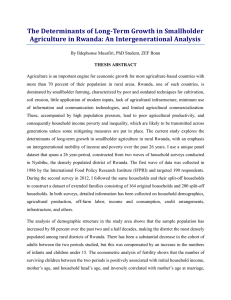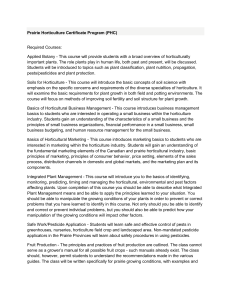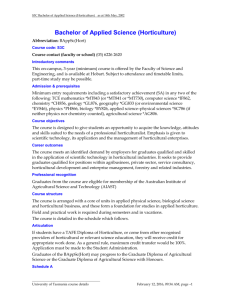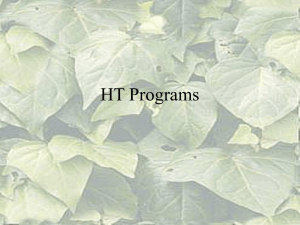Tropentag 2012, Göttingen, Germany September 19-21, 2012
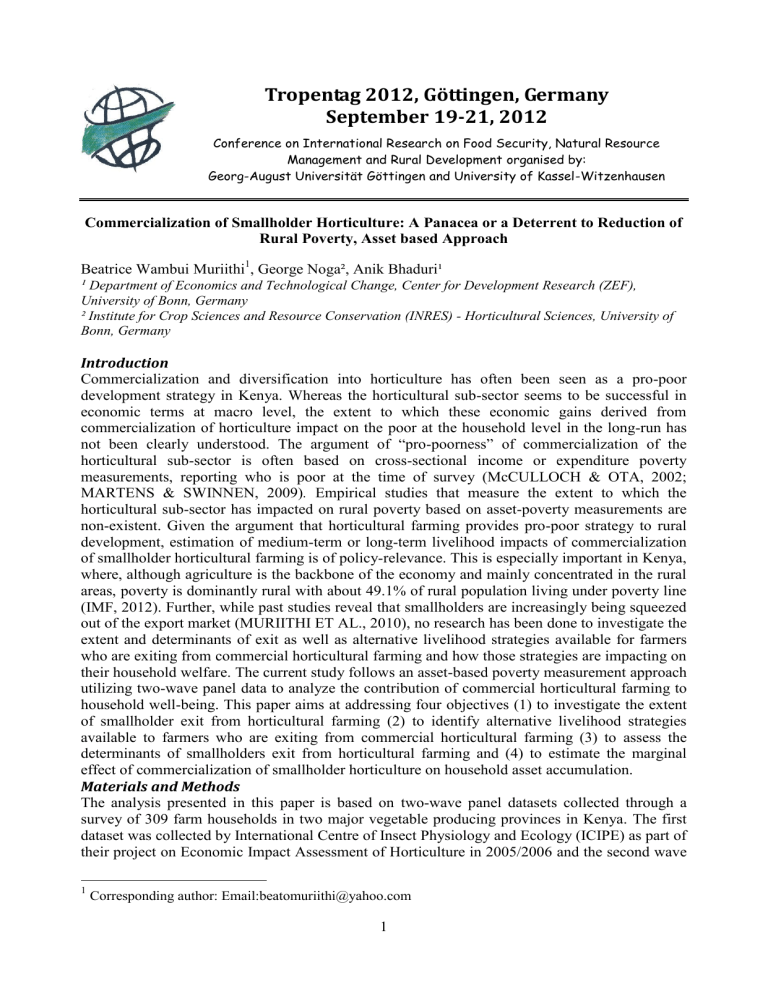
Tropentag 2012, Göttingen, Germany
September 19-21, 2012
Conference on International Research on Food Security, Natural Resource
Management and Rural Development organised by:
Georg-August Universität Göttingen and University of Kassel-Witzenhausen
Commercialization of Smallholder Horticulture: A Panacea or a Deterrent to Reduction of
Rural Poverty, Asset based Approach
Beatrice Wambui Muriithi
1
, George Noga², Anik Bhaduri¹
¹ Department of Economics and Technological Change, Center for Development Research (ZEF),
University of Bonn, Germany
² Institute for Crop Sciences and Resource Conservation (INRES) - Horticultural Sciences, University of
Bonn, Germany
Introduction
Commercialization and diversification into horticulture has often been seen as a pro-poor development strategy in Kenya. Whereas the horticultural sub-sector seems to be successful in economic terms at macro level, the extent to which these economic gains derived from commercialization of horticulture impact on the poor at the household level in the long-run has not been clearly understood. The argument of “pro-poorness” of commercialization of the horticultural sub-sector is often based on cross-sectional income or expenditure poverty measurements, reporting who is poor at the time of survey (McCULLOCH & OTA, 2002;
MARTENS & SWINNEN, 2009) .
Empirical studies that measure the extent to which the horticultural sub-sector has impacted on rural poverty based on asset-poverty measurements are non-existent. Given the argument that horticultural farming provides pro-poor strategy to rural development, estimation of medium-term or long-term livelihood impacts of commercialization of smallholder horticultural farming is of policy-relevance. This is especially important in Kenya, where, although agriculture is the backbone of the economy and mainly concentrated in the rural areas, poverty is dominantly rural with about 49.1% of rural population living under poverty line
(IMF, 2012). Further, while past studies reveal that smallholders are increasingly being squeezed out of the export market (MURIITHI ET AL., 2010), no research has been done to investigate the extent and determinants of exit as well as alternative livelihood strategies available for farmers who are exiting from commercial horticultural farming and how those strategies are impacting on their household welfare. The current study follows an asset-based poverty measurement approach utilizing two-wave panel data to analyze the contribution of commercial horticultural farming to household well-being. This paper aims at addressing four objectives (1) to investigate the extent of smallholder exit from horticultural farming (2) to identify alternative livelihood strategies available to farmers who are exiting from commercial horticultural farming (3) to assess the determinants of smallholders exit from horticultural farming and (4) to estimate the marginal effect of commercialization of smallholder horticulture on household asset accumulation.
Materials and Methods
The analysis presented in this paper is based on two-wave panel datasets collected through a survey of 309 farm households in two major vegetable producing provinces in Kenya. The first dataset was collected by International Centre of Insect Physiology and Ecology (ICIPE) as part of their project on Economic Impact Assessment of Horticulture in 2005/2006 and the second wave
1
Corresponding author: Email:beatomuriithi@yahoo.com
1
was collected in 2011 by the authors. A multi-stage sampling procedure was used to select the districts, sub-locations and smallholder vegetable producers from Central and Eastern provinces.
Based on the intensity of vegetable production, agro-ecology, type of vegetables produced and accessibility, five districts (namely Nyeri, Kirinyaga, and Murang’a of Central Province and
Meru and Makueni districts of Eastern Province) were purposively selected (ASFAW, 2008).
Using Probability Proportional to Size (PPS) sampling methods, 21 sub-locations were selected from the five districts from which a sample of 539 households was selected randomly for the interviews. The list of these households was used as a sampling frame for the second survey from which a sub-sample of 309 was randomly selected for the follow-up visits in 2011. A structured questionnaire was used to elicit information on vegetable production and marketing, other farm and non-farm economic activities as well as household and contextual characteristics. Descriptive statistics were employed to explain the extent of smallholder exit from commercialization of horticulture and to describe alternative livelihoods. Logistic regression was used to evaluate determinants of exit from commercial horticulture while fixed effect (within) regression was used to estimate the marginal effect of commercialization on asset accumulation. To be able to measure asset accumulation, key household assets and poverty indicators were selected, and using Principal Component Analysis (PCA) we developed a household asset index. Following the framework for household asset accumulation adopted from Deaton (1991), we specify an econometric model for asset accumulation as a function of household characteristics including an indicator for commercialization that are likely to affect asset holding and consequently estimate;
Where HH Y is the household income from other sources other than vegetables, Comm is vegetable income and HHxter is a vector of household characteristics that are likely to affect asset accumulation and Other includes other characteristics that might have an influence on asset accumulation. Our interest is to measure econometrically the coefficient of Comm, which contains the estimated effect of commercialization on change of households’ assets.
Results and Discussion
How significant is the extent of smallholders exit from commercialization of horticultural farming and what are the alternative livelihoods ? Commercial farming by smallholder farmers in this study area is through two distinct market pathways: export market and domestic market pathways. While some farmers – when qualifying and given access to the respective chain - specialize either in production of export market vegetables or domestically consumed vegetables, others diversify their income by producing vegetables for both local and export markets. We distinguish participation in either market based on the type of vegetable crops that the farmer is producing. Certain types of vegetables such as French beans are mainly grown for export while others such as cabbages are mainly for domestic market. However, although we use types of vegetables to distinguish the market pathways, it is important to note that formerly exported crops such as French beans are also increasingly being consumed locally especially in the urban areas. The percentage consumed by the domestic market is however very small and not documented to warrant disaggregation between produce sold locally and that sold to the international market. A similar case applies to domestically consumed vegetables such as peas and baby carrots, which are currently being exported.
Descriptive analysis shows that households producing vegetables for commercial purposes declined between year 2005 and 2010. As can be seen in Figure 1, the percentage of households specializing in production of domestically produced vegetables increased from 25% to 42% between 2005 and 2010, while those specializing in export market vegetable production decreased by 10% during the same period. Twenty percent of the households however abandoned production of vegetables altogether.
2
Observing a significant number of households exiting from horticultural farming, the next question is to find out the alternative livelihoods available to such farmers. To answer this question, we readdressed in the current survey the question regarding the major activity of household heads as asked in 2005. Thirtyone percent smallholder who cited vegetable enterprise as their main source of livelihood in year 2005 did not consider this activity as so in 2010. Twenty nine percent of them cited business as their main activity in 2010; about 21% were involved in cereal production while 13% were engaged in casual labour and other short-term activities. The importance of small rural-based businesses as options for aiding households to climb out of poverty has been alluded to in other studies such
RADENY ET AL. (2012).
What are the determinants of smallholders’ exit from horticultural farming?
Participation in commercialization of horticulture can be viewed as a binary choice decision problem by farm households that try to maximize utility or net returns. Utility is determined by a set of variables that influence the ability of the household to participate in a particular channel. This includes the ability to adjust costs to meet specific market pathway requirements. Some of these variables include farm and farmer characteristics such as household size, asset endowment, access to nonfarm income, and transaction cost related indicators such as distance to the nearest market town.
Motivated by the theory of utility maximization, we explore the reasons why some smallholders exited from commercial horticulture from the 20% households who were recorded as non-sellers in 2010. Descriptive analysis reveals (data not shown) that about 44% exited due to low produce returns (per unit area) as a result of fluctuating produce prices and high cost of labour and other inputs. About 36% cited the problem of lack of water for irrigation while 21% cited the problem of lack of capital to finance increasing cost of labour and other farm inputs and to maintain food safety and quality standards such as GlobalGap especially among export market producers. To properly relate the variables that determine utility maximization behavior of households to exit from commercial vegetable production, we applied logistic regression model
2
to the 115 households who considered horticulture as their main livelihood activity in 2005 but not as so in
2010. The dependent variable is a binary variable given as 0 if household considered horticulture as main activity in 2005 and 1 if the same household did not consider the activity as important in
2010. Empirical results show (data not given here) that high dependency ratio, ownership of more assets, availability of remittances and ownership of small business enterprises are significantly and positively associated with probability of exiting from commercial horticultural farming as main livelihood activity. On the other hand, households with higher land endowments and have access to extension services are likely to remain in commercial production of vegetables.
What is the marginal effect of commercialization of smallholder horticulture on household asset accumulation? Using fixed effect (within) regression, we find positive but insignificantly small marginal effects of vegetable income on asset accumulation. However, interaction between
2
Ideally Fixed effect or GLS random effects would be used in this case since we are using panel dataset. However, after dropping Fixed effects for Random effect model guided by Hausman test, the rho (ƿ) of the Random Effects results was zero (tested using Likelihod-ration test), meaning the panel-level variance componet was unimportant and thus the results are not different from a pooled estimator. Thus a pooled estimator (logit) – logistic regression was applied.
3
domestic market pathway dummy and year 2010 dummy shows a positive difference between domestic market pathway and non-sellers on asset accumulation between year 2005 and 2010
(data not shown). This is in contrast to the interaction between export market pathway and year dummy whose coefficient was insignificant. Looking at the patterns of change of per capita assets and per capita income between the five-year-period, we are confronted with mixed results.
Overall per capita assets declined by 3% while per capita income increased by about 8%. A similar pattern was observed across households specializing through different market pathways.
Per capita asset for households specializing in production of domestic market vegetables decreased by 3%, while that of export market-oriented producers decreased by 1%. On the other hand, per capita income increased by 34% among domestic market producers and by 37% among export market producers. Similarly, per capita asset for farmers who abandoned horticulture business reduced by about 10%, while per capita income increased by about 40%. These differences are nevertheless not statistically different between the two data periods.
Conclusions and Outlook
The above discussion reveals that smallholder farmers continue to be squeezed out of the horticultural business and especially so from the export market. However, domestic market for vegetables, small rural based businesses and other off-farm activities present economic prospects for such farmers. The results also reveal limited potential of income generated from vegetable enterprise to raise household assets. This finding contradicts with other studies that used income to measure poverty effects of commercialization of vegetables (MCCULLOCH & OTA, 2002;
MAERTENS & SWINNEN, 2009). In this study we also observe increase in per capita income but decreasing per capita asset. This implies that to provide a better understanding on the relationship between commercialization of smallholder horticulture and rural poverty, researchers should not use one measure of poverty, for example income, but should integrate other poverty dimensions such as assets. Policy implication focuses on development of marketing infrastructure and institutional support (including promoting access to extension services) for smallholder to be able to access domestic (and export) markets, creating a better investment environment to promote small rural based businesses and exploring the potential role of safety nets to allow investment in household assets. Further research should explore intra-household distribution of income generated from horticultural business.
Acknowledgements
The authors would like to thank the German Academic Exchange Service (DAAD) and Dr.
Hermann Eiselen, Doctoral Programm of the Foundation Fiat Panis for funding support. We would also wish to thank the International Centre for Insect Physiology and Ecology (ICIPE) for providing secondary data and to individual farmers who participated during the second round of the survey.
References
ASFAW, S. (2008). Global Agrifood supply Chain, EU Food-Safety Standards and African Small-Scale producers-
The case of High-Value Horticultural Export from Kenya. Pesticide policy project, Leibniz Universitaet Hannover.
DEATON, A. (1991). Saving and Liquidity Constraints. Econometrica , 59(5), 1221–1248.
IMF (2012). Kenya: Poverty Reduction Strategy Paper - Progress Report (IMF Country Report No. 12/10).
Washington, D.C.: International Monetary Fund (http://www.imf.org/external/pubs/ft/scr/2012/cr1210.pdf).
MAERTENS, M., & SWINNEN, J. (2009). Trade, Standards, and Poverty: Evidence from Senegal. W orld
Development , 3, 161– 178.
McCULLOCH, N., & OTA, M. (2002). Export Horticulture and Poverty in Kenya. Institute of Development Studies,
University of Sussex, Brighton (http://www.eldis.org/fulltext/mcculloch_neil_export_horticulture_2002.pdf)
MURIITHI, B. W., MBURU, J., & NGIGI, M. (2010). Constraints and Determinants of Compliance With EurepGap
Standards: A Case of Smallholder French Bean Exporters in Kirinyaga District, Kenya.
Agribusiness, 27, 1–12.
RADENY, M., VAN DEN BERG, M., & SCHIPPER, R. (2012). Rural Poverty Dynamics in Kenya: Structural
Declines and Stochastic Escapes. World Development, 40(8), 1577–1593.
4
